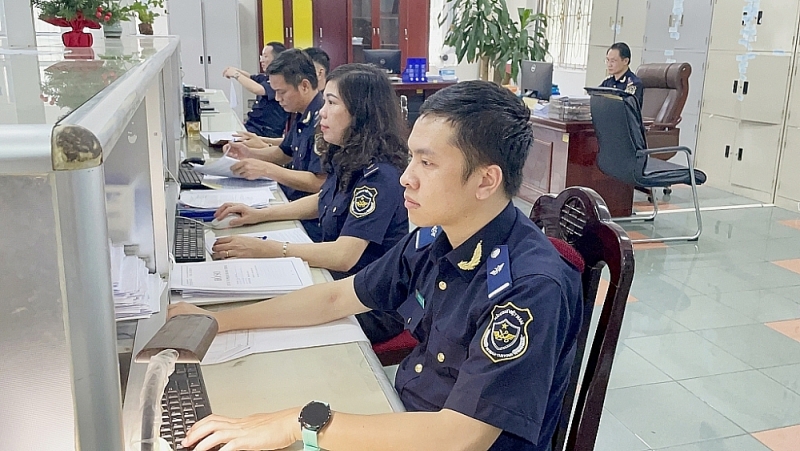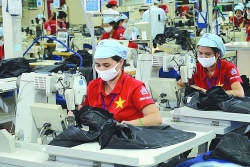 |
| Professional activities of officers of Phu Tho Customs Sub-Deparment (Hanoi Customs Department). Photo: N.Linh |
Facilitating the application of new agreements
Currently, Circular replaces Circular No. 38/2018/TT-BTC, Circular No. 62/2019/TT-BTC, Circular No. 47/2020/TT-BTC and Circular No. 07/2021/TT-BTC regulating the inspection and determination of the origin of exported and imported goods developed and completed by the General Department of Customs after many rounds of consultation with relevant parties.
According to the Customs Supervision and Management Bureau, the new draft circular will merge the contents of instructions for inspection and determination of the origin of exported and imported goods in the above Circulars to develop a replacement circular to facilitate the research and implementation process; overcome problems and inadequacies in the implementation process such as declaring and submission of certificates of origin; using the notice of prior determination of origin, additionally submit C/O after the goods have been cleared, submit C/O in case that the goods change their purpose of use, regulations related to the time of submission of C/O, about the cases to submit C/O.
The issuance of a new circular also aims to standardize and unify regulations on inspecting and determining the origin of exported and imported goods in accordance with international commitments. The reason is that at the time of issuance of Circular No. 38/2018/TT-BTC, new generation free trade agreements (such as CPTPP, EVFTA, UKVFTA, RCEP) have not been signed for implementation, so there is no guidance in Circular No. 38/2018/TT-BTC.
According to the Customs Supervision and Management Bureau, on the basis of the overall assessment and review of the implementation of circulars, there have been many shortcomings in the management of the origin of goods such as the way to manage and check documents of origin self-certification for enterprises licensed under the code REX (EVFTA Agreement), EORI code (UKVFTA), CE (ATIGA Amendment Agreement and RCEP Agreement).
In addition, many management requirements under a new approach such as applying a guarantee for debt goods, late submission of certificates of origin, form of submission of certificates of origin (submitted through the V5 system, submit copies) need to be supplemented and specifically guided in the Circular so that the Customs has a legal basis to implement.
The Customs Supervision and Management Bureau said that the new draft circular would meet the requirements of implementing activities related to customs modernization, creating a legal basis for the application of new forms of certification of origin.
At the same time, detailing a number of articles of the Customs Law, Decree No. 59/ND-CP on customs procedures, customs inspection and supervision; Decree No. 31/2018/ND-CP on the origin of goods and compliance with international commitments on origin to which Vietnam is a member.
Facilitating enterprises to submit C/O
A representative of the Customs Supervision and Management Bureau said that a notable provision in the draft Circular was the time to submit documents certifying the origin of goods. The draft circular would inherit the superior contents of the current regulations. In order to reduce administrative procedures for enterprises, reduce risks for customs officers, and move towards paperless customs, the draft Circular did not stipulate that customs declarants must submit a paper copy, but only need to scan it and send it through the system to the customs authority and for the pre-determined notification, the declarant was not required to submit the original document, which the customs officer would check on the system.
Or regulations on inspection, identification and verification of origin for exported goods, the draft Circular retains the contents of regulations on inspection and determination of origin for exported goods. However, in order to ensure convenience for the relevant parties when studying and implementing, the draft Circular has added a specific guiding article on the declaration and submission of certificates of origin of exported goods.
In addition, on the basis of comments from the units on amending and supplementing in accordance with the post-customs clearance inspection process, clearly guide how to check and handle when detecting violations, the Customs Supervision and Management Bureau has received and supplemented clear instructions on export goods inspection and verification procedures to match the post-customs clearance inspection process, clearly guiding the documents that the declarant must submit to prove the origin in case that the Customs has a basis for doubt as well as clearly guide the steps to be taken, the content of inspection and method to handle it.
 | Overcoming the challenge of rules of origin to make good use of CPTPP |
Regarding the form of certificates of origin for imported goods, in order to be consistent with commercial practice and international commitments in new FTAs, the draft Circular stipulates that for agreements applying self-certification of origin that Vietnam is a member such as CPTPP, EVFTA, ATIGA, together with C/O, customs declarants can choose self-certification of origin documents for goods subject to export management.
